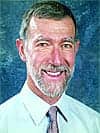Pediatric Home Services provides respiratory and other health care services exclusively for technology-dependent children
When an adult is chronically ill with specialized health care needs, a family can turn to many services that will help manage the patient at home. But when an infant—or a toddler, or even a teenager—is chronically ill with specialized health care needs, and the family wants that child to live at home, parents have even greater considerations.
Susan Wingert, president of St Paul, Minn-based Pediatric Home Services (PHS), says, “If I’m on a ventilator as a cognitive adult, but physically challenged, I can direct my own care. I can participate actively in that care. A 6-month-old baby has no ability to do that.” Likewise, the care of a 6-year-old child can be radically different than the needs of an adolescent.

Recognizing these differences, Wingert, a former respiratory therapist, founded PHS in 1990 as a children’s home care agency for respiratory care. Sixteen years later, PHS still serves children’s respiratory needs and also provides infusion therapy, educational programs, social services, and many other services for technology-supported children and their families.
From Cradle to Teenagers
There were several factors that made Wingert decide to focus exclusively on pediatric services. “First, we truly loved the business of children,” Wingert says, “and second, we had the advantage of a group of pediatric pulmonologists that came to town in the late 1980s. These doctors believed that children had a right to live in the home. We also have a payor community and a state community that believe everybody has a right to health care, and that everybody has a right to a [high] quality lifestyle.”
Wingert points out that most home care agencies offer “cradle to grave” service, but that the aging American population provides the lion’s share of revenue for home care agencies. Despite that security, Wingert went forward and created PHS just for children.
She says, “I can’t possibly tell you that back in 1989 we thought our business would be as large as it is. We really thought [the pediatric home care market] was somewhat self-limiting. However, what our crystal ball didn’t show was the incredible progress that medicine has made in saving and rehabilitating and changing the lives of kids, who 10, 12, maybe 15 years ago would not have lived. Now, they not only live, but thrive.”
PHS began modestly in 1990, establishing a high-tech respiratory care program for children in the home. Then in 1995, an insurance company suggested that Wingert and PHS could help reduce asthma in children by creating in-home asthma education. Wingert thought it was good advice and added two certified asthma educators. In 1997, once again at the suggestion of an insurance company, PHS added home infusion therapy for children. Since then, it has continued growing, adding nutritional counseling, a specialty pharmacy, wound care, and access to social services.
PHS offers comprehensive pediatric respiratory care services, including:
• food pumps
• heat and humidity systems for tracheotomy patients
• oxygen systems
• bilevel/CPAP systems
• portable and stationary suction devices
• percussors
• in-home asthma education (environmental assessments, nebulizer therapy, personal triggers, plus other services)
Wingert says that all of the company’s services are vital to the company, but she notes that having on-site social services is a useful complement to the entire PHS program.
“Our therapists, nurses, pharmacists, and dieticians knew that they wanted to help a kid, but they didn’t know what [financial] resources were available to do that,” she says. “And because they weren’t schooled in learning how to ferret them out, sometimes they didn’t feel like they did a good job. So a social service team came in and started to help and provide all those aspects of care.”
Children Are Different
There are many aspects of pediatric home care that distinguish it from adult and geriatric services. One of the first things a therapist has to keep in mind is the child’s age. An infant, especially a premature infant, is not only physically and cognitively helpless, its immune system is also weaker than that of any older child or adult. Consequently, infection control is very important, and the child’s home must be sanitized and properly prepared. Additionally, family members must be taught how to minimize the risk of infections.
Wingert says, “The assault that we have today from viruses, bacteria, etc, really has to be looked at from a different perspective. What will work for adults because they have this intact immune system probably needs to be looked at a little differently in a child.”
Size and age also affect the equipment and medical supplies that the therapists use. For example, PHS stores different-sized tracheotomy tubes that are much smaller than those used for adults.
Providing the right amount of nutrition to a technologically dependent child is also paramount to their continued growth. Whereas an adult may require a relatively stable number of calories for their weight, children increasingly need more nutrition as they grow in size. PHS nutritionists help families so they can administer the correct, balanced diet as the child ages.
Some children require total parenteral nutrition (TPN), and must have their nutrition and/or medications intravenously. An adult may understand the necessity of being stuck by a syringe—or having a titration mask being put over their face—but a young child will probably be frightened and confused. Likewise, a parent may be hesitant about applying those therapies if the child appears in distress.
Wingert says, “No matter how much a mom and a dad want to take care of the kid, technology like that is frightening. So it takes a lot to inspire the parent’s confidence in taking care of the child.” PHS therapists show parents how to help the child not to fear them and to reduce their own anxiety when applying medications.
Preparation and Training
Of course, PHS does not simply hand parents an instruction booklet and a ventilator and wish them luck.
First, PHS therapists and social workers develop a home care strategy with the family and physicians. The plan includes the services and supplies that might be needed—durable medical technology, nutrition, medications—and a schedule for PHS therapists who will be working with the families at home. At the same time, PHS clinicians review the patient’s medical history and the needs and time constraints of the family.
Next, PHS gives family caregivers a thorough education and training about the technology before the physician approves the release of their child from the hospital.
The family’s education is both verbal and hands-on with many supporting written materials. PHS also employs a technical writer, who helps in crafting in-house booklets that simplify the manufacturer’s instruction manuals, which PHS also provides and encourages families to read. The PHS booklets include sections that address the technology and medications, if any, as well as support and trouble-shooting. In addition, PHS gives families a laminated single-page quick reference guide that condenses the most important information into bullet points. Typically, parents keep this laminated sheet by the child’s bed. PHS also has hired a local video production company to begin making DVDs that will demonstrate the function and care of the technologies.
As the family is being educated, PHS clinicians assess the home and address any safety issues, problems with storage of medical materials, and infection risks. Then the prescribed equipment is installed into the home prior to discharge so that parents have an opportunity to see, hear, and work with the equipment before the child is dependent upon it.
When the child is at last discharged from the hospital, a PHS therapist is always in the home, working with the family and often with a nursing agency, to ensure the child’s comfort. Clinicians then visit the home several times over the next week, making sure all the machines and protocols are being followed. Depending on the family’s needs, therapists will return twice or three times a month to check in and see if there are any concerns. Additionally, parents are able to contact PHS employees 24/7 when they have any urgent problems or questions.
Partners in Caring
Wingert sees PHS as being comprised of “partners” in caring for the child. She says that these partners include physicians, the family, the payor community, outside physical and occupational therapists, and, of course, her own staff. Currently, PHS’s therapists and nursing staff include:
16 RRTs
1 Social Worker
3 Dieticians
4 Specialty Pharmacists
7 Registered Nurses
2 Certified Asthma Educators,
2 RNs who work in the RT department
2 LPNs who work in the RT department
Finding health care human resources is difficult for any health care facility, but Wingert says that it is even more challenging for PHS. Therapists not only have to competently perform their tasks, they also must inspire confidence in the families and the children. Wingert is sure that her staff has all these qualities and more.
She says, “They’re caring, and they’re dedicated to ensuring that the child is taken care of and that there is a safe-care plan in place. So bar none, they are the finest respiratory therapists I’ve ever had the privilege of knowing.” She goes on to credit her entire therapy and administrative team for their compassion and commitment to the children.
One indication of PHS’s commitment to both its clients and its employees is its fleet of Toyota Prius hybrid vehicles, which the therapists use to visit patients. “If you’re going to get a kid well and then send them out into the world that’s polluting and ruining their lungs, it’s a little hypocritical,” Wingert says. “So I said, if we’re going to get around, we’re at least not going to harm the environment any more than we have to.”
The Future of PHS
Aside from its fleet of new hybrid vehicles, PHS has just remodeled its facilities and now feels that it is ready for the future. Staff members often sit down together and discuss new trends and how they can meet unmet needs of their local pediatric community. Wingert stresses that, while they have just expanded their facilities, they are focused on the St Paul-Minneapolis area.
Wingert says, “We are not going to go national and we are not going to go regional. We’re just a little somebody that takes care of kids in Minnesota and western Wisconsin, northern Iowa, and the eastern Dakotas.”
Tor Valenza is a staff writer for RT. For more information, contact [email protected]










